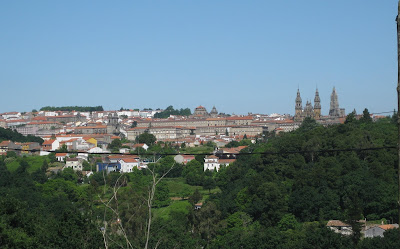 |
| The many ways to Santiago © John Brierley |
Camino Fisterra
In our several camino ramblings between 2007 and 2014 (walking some 1500 kms) we have approached Santiago from all cardinal compass points. The most beautiful approach to the ancient cathedral is undoubtedly from the west: the last few miles of the lesser trodden
Camino Fisterra give wonderful views of old Santiago de Compostela with the cathedral spires standing tall and proud in the distance, urging one onwards and upwards.
Most of the people who do this walk make it an add-on from Santiago, continuing westwards to the end of the known world, as Finis Terre was considered up the time of Columbus, but it is perfectly acceptable to do it in the reverse order, and starting in Muxia one has the opportunity of a refreshing ocean dip before setting out to Fisterra (Finisterre), Cee and Negreira over a gentle five or six days. It is about 110km long, through peaceful farmland and by pristine beaches, and qualifies for the
compostela or pilgrim certificate. It is the shortest of all the caminos, and is a delightfully quiet and refreshingly peaceful alternative to the increasingly crowded and hectic final stages of the more famous
Camino Frances from Sarria, about 120km east of Santiago.
 |
| Nosa Senora da Barca near Muxia |
 |
| Path into Muxia |
 |
| Broom along the way |
 |
| Pria de Langosteira beside Fisterra |
 |
| The goal: Santiago cathedral from the Camino Fisterra |
.........................................................
Camino Ingles/Celtic Camino
Approaching Santiago from the north gives an opportunity to savour the countryside traversed by our forebears who together with English, Welsh and Scottish pilgrims would have traveled by sea to La Coruna or Ferrol and thence along the
Camino Ingles. Most of us nowadays will arrive into Santiago by plane, and travel by bus to Ferrol, which is 120km from Santiago.
Again this is a peaceful and delightful Way, with kindly hostels and small hotels en route, and far less travelers so there are no difficulties in finding beds at the end of the walking day. This route was our first ever Camino back in 2007 a few months after my brother's death, and I returned to it again in 2013 with his widow and a group of friends from Australia. The
Irish Camino Society have recently done great work in popularizing this route by enabling an Irish add-on walk of 25km to extend the route from A Coruna (which is 75km from Santiago and therefore of itself doesn't qualify one for the
compostela), calling it the
Celtic Camino
Being entirely through Galicia, one will usually experience a day or two of rain - but pilgrimage wouldn't be authentic without some little difficulty!
 |
| Frank sheltering from a shower, 2007 |
 |
| Typical albergue en route : this dorm we had all to ourselves |
 |
| Beach at La Magdalena outside Puentedeume - May 2007 |
.....................................................
Camino Portugues
Coming from the south is the
Camino Portugues, growing in popularity as a good alternative to the French Way. This has so many attractions and we very much enjoyed it back in 2009, our second ever camino. We went in the bountiful month of September, and took twelve days to walk the 230 kms from outside Porto. We were almost doubling our previous mileage, and the heat at that time of year made us seek shady siestas at midday. Passing from one country into the other at the River Minho which marks the boundary between Spain and Portugal adds an extra dimension, as one changes not only language and architectural styles, but even the hour! Spain is more modern and more highly populated along the camino here, but the language is more approachable, though Gallego and Portuguese have a lot in common. Much of the path is shared by the pilgrim route to Fatima favoured by the Portuguese who don't have as much interest in continuing north to Santiago.
 |
| Across the Minho and into Spain |
 |
| Collecting the grapes |
 |
| Bounties of the Camino Portugues , 2009 |
There are differences too in the food, though both countries offer the wayfarer excellent pilgrim menus at ridiculously cheap rates. As a contrast to the many simple hostels along the way, we sampled some of the beautiful
Quintas or country houses offering a higher standard of accommodation:
this one is owned by an English couple who treated us royally and gave a generous pilgrim discount as well!
 |
| Quinta do Convento da Frangueira |
 |
| Casa dos Assentos at Quintiaes near Barcelos |
Another delightful accommodation was at the
Casa dos Assentos , a lovely manor house where Senhora Julia provides wonderful home cooking to tired pilgrims and other guests. We certainly lived it up at this stage of the Camino Portugues, but spent far more nights in simple albergues!
These are three caminos which we have sampled and enjoyed. I will leave the final compass point, east, to the Camino Frances. Check out my next post for that!
































